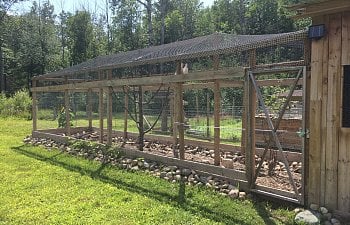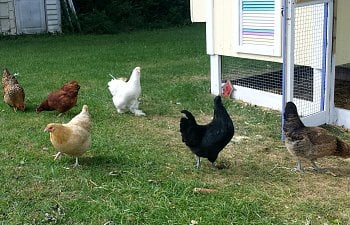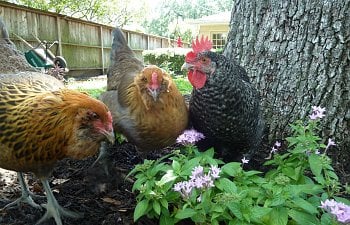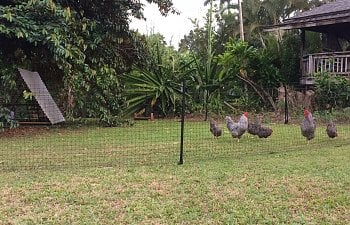Anyone wanting a simple answer to the question of how big to build a coop or run for a given number of birds can simply do an internet search, get a random number, and be “done.” However, optimizing your chicken zone to truly make the most of available resources, save yourself the most amount of work and hassle, and—certainly not least!—have the healthiest and happiest flock possible does require giving the matter a little bit more thought. But never fear! That doesn’t mean it has to be really complicated, either--just a little bit complicated. Below are some points that may help to demystify the notion of “stocking density.” I hope this can aid those about to embark on keeping chickens for the first time by clarifying important factors to be aware of, while perhaps even giving veterans some new ideas that might improve existing coops even further. Because after all, how you set up your chicken zone is really more than half the battle when it comes to keeping happy, healthy, productive fowl while keeping yourself happy, healthy, and productive.
#1: Bigger is Basically Better (or, “Why 200 Square Feet is Waaaay More than Twice as Nice as 100”)
The title really says it: assuming you are able to devote (or “loan,” see #6 also, below!) the “extra” space, bigger really is usually better. More space per fowl means droppings and scratching activities are more dispersed, so the chicken-inhabited-area(s) require less work to maintain. One example: a grassy pasture of 5000 square feet with a dozen chickens on it can stay green and clean and pretty for a long time, while a grassy run of 50 square feet with a dozen chickens on it will be disgusting and unhealthy after a single day. Additionally, more space means more “elbow room” for the chickens and so less squabbling, bickering, bullying, and all the other strife that will occur whenever any animals (including people) are crowded to the point where they constantly get in each other’s way and feel constrained. The stress of crowding also impairs health and immunity, even as closer quarters also mean that any contageous illness, should it occur, is likely to spread farther and faster.
There is often a temptation to use as little space as you “can afford” for such enterprises, and a vague notion that anything beyond some arbitrary minimum is “a waste of space” or “inefficient;” I strongly encourage you to question such reflexes. For instance, it seems to me that spending extra time every single day trying to keep a tiny, crowded coop clean and constantly worrying about diseases and cannibalism—while simultaneously maintaining a large empty lawn immediately adjacent to that coop (that could instead be used to pasture chickens), is a more salient example of “inefficiency.”
One final, yet potentially crucial consideration: more space can also mean more opportunity for your chickens to forage for wild foods like edible bugs, worms, fruits, weeds, seeds, etc., especially if you intentionally incorporate areas with these resources of into your outdoor chicken zone. This has the potential to reduce the amount of feed you buy (in some cases dramatically) while providing naturally healthy nourishment and stimulation for your feathered friends. Large outdoor areas with naturally occuring grit in the soil also negates the need to artificially supply the grit chickens need to digest their food well.
When in doubt, providing as much quality room as you can for your flock, in whatever way works best for you (even if that means considering a smaller number of birds than you may originally have envisioned, see #2 below), is virtually guaranteed to make your life, and your chickens’ lives, vastly easier and more pleasant.
#2: How Many Chickens Do I Actually Need? (or, “How to Get an A+ in Chicken Math”)
Generally, chickens are fairly easy to acquire, and to acquire in bulk. This can lead to numerous variations of the infamous “chicken math,” whereby people over time find themselves with many more chickens than they started with. Unfortunately, each time you add chickens to a flock, you reduce the share of coop and run space each bird has. Too many chickens also means higher feed costs and more work and hassle. Of course, it’s not “chicken math” per se that is a problem: just that which isn’t well planned—or doesn’t involve subtraction as well as addition.
Too many people just “get some chickens,” perhaps in arbitrary round numbers (been there, done that!), without seriously considering the size of the flock that might best fit. By doing some estimating to figure out the ideal minimum flock size that will meet your needs and desires, as well as by culling older or otherwise less productive birds whenever you bring in new young ones, you will maintain the maximum amount of space per chicken that you are able to offer your flock at any given time.
#3: Not all “Space” is Equal (or, “When in Rome, Use the DLM”)
Since chickens will just poop anywhere and everywhere they go, a big part of maintaining your chicken zone will always involve seeing that the ground (or floor) can handle the poop that falls on it without becoming a smelly, unhealthy place. There are basically two broad approaches to doing this that are straightforward to implement, healthy, low-maintenance, time-tested, and broadly applicable: deep litter and natural pasture. The first works very well for smaller areas indoors or under cover that tend to be more heavily populated, the second for larger outdoor spaces where birds are more spread out.
Please note that I adopt the use of the word “pasture” here and elsewhere not just in the classic pastoral sense, but in a more chicken-centric way that includes not just open, grassy turf but any sizeable enclosure of natural terrain exposed to the elements, including scrubland, tall weeds, brushy thickets, savanna, woodland, orchard, fallow fields and gardens, or combinations of these. This is because chickens—unlike cows, sheep, or so many other denizens of pasture—are not grazing herbivores, and thus the value of “pasture” for poultry neither begins nor ends with grass; also, chickens are native to woodlands, where they hunt, forage, roost in trees, and hide under cover of foliage to avoid predators and stay cool during the heat of the day—they are ill-adapted to live entirely in open grasslands.
“Hey, where are you wandering off to?!” I hear you say. “This is supposed to be an article about how big to make my coop and run, not what to put on the ground inside it!” Well, actually, what’s on the ground makes a huge difference in how much space you need to allow for it to remain workable. In other words, context is everything. For example, five chickens might be kept happily on litter two feet deep in a stationary covered run that’s 10’ by 10’, but a 10’ by 10’ stationary “grassy” run is going to become a feces-caked hellhole very quickly (and not so grassy).
Deep litter involves establishing a thick layer of organic matter inside coops or other sheltered areas that stay relatively dry. Chickens generally take to it very well because it simulates the forest-floor detritus that is part of their ancestors’ natural habitat, and thus they enjoy scratching around in it, which also incorporates manure and keeps it from caking on the surface. Basically, you provide enough dry, carbonaceous litter material that the wet, nitrogen-rich poop simply gets mixed into it and “disappears” before it ever builds up enough to stink. Thus, intuitively, the more traffic or birds in a given area, the deeper the litter should be. Dried leaves, chopped straw, wood shavings (all non-toxic and pesticide-free, of course) or a mixture can all work for this—consider what may be most readily and affordably available locally. Very large or coarse materials will work better shredded first. Deep litter seems to work best on a natural dirt floor, but can certainly be adapted to other surfaces. Unlike “shallow litter,” deep litter does not need to be mucked out freqently and replaced; it can generally remain in use for months at a time, though some can certainly be removed as needed for use as fertilizer or mulch—it is far less concentrated and fresh than pure, raw manure so less likely to “burn” your plants, but if in doubt you can age or compost it first.
Natural pasture, on the other hand, works well for large, open areas where chicken activity and poops can be spread out over a large enough space that they won’t significantly upset or destroy the existing habitat but simply become part of it. Many pastures are grassy, since turf is pretty, absorbs droppings, stands up to animal activity and weather well, and offers some green feed (chickens are omnivores, and thus cannot survive on greenery alone, but they will eat a fair amount of certain grasses and weeds and be healthier for it). But pastures also can (and if available, should) include areas of more diverse habitat such as thickets, bushes, trees, dirt, and leaf litter as well. Fallen leaves and similar provide ample opportunity to scratch for bugs and other small prey, and dry dirt areas provide natural dust bathing opportunities which are important for chicken hygiene. And the cover of trees and shrubs offers some protection from aerial predators and the hot sun. Grassy or weedy pasture areas will have to be mowed, scythed, or grazed down at least occasionally to prevent them from becoming overgrown and to provide the chickens with tender new growth to browse.
People tend to underestimate the amount of impact a given number of chickens will have on a pasture of a given size. If you don’t have the space for the number of birds, you can set up a system such that you can easily and frequently rotate the area that they have access to. (Please note: I do NOT recommend as a GENERAL plan allowing access to pasture only occasionally or for short periods each day, especially if this will be sporadic—this can be both cruel AND inefficient, as the birds will then tend to spend a lot of time and energy pacing and pining for freedom when they are shut in.)
Zones that fall somewhere in between deep litter and pasture areas—such as relatively permanent high-traffic zones around doorways, feeders and waterers, etc. that are exposed to the elements—can benefit from a light layer of wood chips, fallen leaves, or coarse straw or grass as needed to keep them fresher and cleaner.
#4: Consider Breeds and Sizes (or, “A Bantam is Not an Orpington—Unless It’s a Bantam Orpington")
This sort of speaks for itself, but is important to think about nonetheless. Smaller-sized chickens can be kept happily in smaller-sized areas; calm and placid birds tolerate limited spaces better than active, flighty ones. If space is severely limited, you might consider bantam chickens and/or famously mellow breeds like Silkies or Brahmas. On the other hand, those with plenty of chicken space may prefer the more active, flighty birds because they are likely to be more enthusiastic about foraging and be more adept at evading hawks and such while doing so. There truly is a chicken breed for nearly everyone and every coop.
#5 Think Outside the Box (or, “Why Math Matters, Part 2”)
Some more things to ponder:
“Chicken coops/runs don’t need to be square or rectangular.”
Think about it: a circular pasture made with 100 feet of fencing has a larger area than a square made with the same fencing, which in turn has a larger area than any rectangle with the same perimeter. People often bemoan the expense of fencing—it is after all one of the major expenses of keeping animals. But consider that by taking the same fencing material you would use to build a 10’ by 20’ chicken run and arranging it into a circular run instead you increase the area of that run from only 200 square feet to just over 286 square feet without spending a penny more on fencing! Whoa... mind = blown!
Or, maybe your backyard is triangular...? In that case, you have my sincerest sympathies...
#6 Portable Coops and Rotating Runs (or, “Unlike Plants, Animals Can Move Around!”)
In general, you can to some extent get away with providing less space at one time if you must by moving chickens more frequently. Even when space is not at a premium, by regularly rotating the areas your chickens are on, you allow the areas time to recover in between while freeing up space for other uses and breaking up the parasite cycles. For instance, you might garden in one spot, keep chickens in another and rotate seasonally—your fallow garden space can double as a chicken run and your resting chicken space can double as a garden, with minimal space “wasted” (while your garden is fertilized by chicken droppings and your chickens feed on bugs and any crop leftovers).
Very small flocks of mellow birds, or groups of young adolescent chickens, can be kept in “fold pens” or “chicken tractors” that are moved daily, gradually migrating over large, flat areas or down the length of fallow garden beds, while tying up minimal space at any given time. Larger flocks are frequently carted about in “eggmobiles” (henhouses on wheels) and turned out to new pasture regularly (with or without perimeter fencing). The venerable Balfour method combines many of the benefits of these with the convenience and security of a permanently sited, sturdy henhouse surrounded by multiple pastures that can be rotated in turn (traditionally using fixed fencing but nowadays easily and usually more cheaply done with portable net fencing). Many other possibilities abound, some of which may be unique to your own space, needs, resources, and circumstances. Be creative!
~~~
And finally, learn to listen to your birds and observe them. They can often tell you a lot, if you know how to pay attention! Chickens are quite remarkably, constantly, vocally expressive.
Ultimately, though we always like simple answers, there is no single, arbitrary, universally appropriate answer to the question of “how much space to allow per chicken.” But hopefully, now you can have an even deeper understanding of the factors involved, so you can best decide how much space is right for YOUR flock.
~~~~
The author lives and works on a small organic farm in Hawaii where he has kept a few different types and breeds of standard chickens for over 25 years, at times variously in outdoor pastures, “tractors,” and also a covered pole barn with deep litter and an attached “composting run.” He and his family currently manage a dual purpose and breeding flock of American Dominique chickens (that fluctuates in size each year, but is kept at around just over a dozen adult chickens) living in a movable orchard pasture of grass and fallen leaf litter. It varies in size between about 1200 and 1700 square feet—depending how many randomly spaced trees and other obstacles he has to negotiate with—and gets moved about once every 3 to 4 weeks (younger chicks typically live separately in a nearby small, lightweight “chick tractor,” moved daily, until they are old enough to be integrated).





